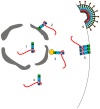Orchestrating the Selection and Packaging of Genomic RNA by Retroviruses: An Ensemble of Viral and Host Factors
- PMID: 27657110
- PMCID: PMC5035971
- DOI: 10.3390/v8090257
Orchestrating the Selection and Packaging of Genomic RNA by Retroviruses: An Ensemble of Viral and Host Factors
Abstract
Infectious retrovirus particles contain two copies of unspliced viral RNA that serve as the viral genome. Unspliced retroviral RNA is transcribed in the nucleus by the host RNA polymerase II and has three potential fates: (1) it can be spliced into subgenomic messenger RNAs (mRNAs) for the translation of viral proteins; or it can remain unspliced to serve as either (2) the mRNA for the translation of Gag and Gag-Pol; or (3) the genomic RNA (gRNA) that is packaged into virions. The Gag structural protein recognizes and binds the unspliced viral RNA to select it as a genome, which is selected in preference to spliced viral RNAs and cellular RNAs. In this review, we summarize the current state of understanding about how retroviral packaging is orchestrated within the cell and explore potential new mechanisms based on recent discoveries in the field. We discuss the cis-acting elements in the unspliced viral RNA and the properties of the Gag protein that are required for their interaction. In addition, we discuss the role of host factors in influencing the fate of the newly transcribed viral RNA, current models for how retroviruses distinguish unspliced viral mRNA from viral genomic RNA, and the possible subcellular sites of genomic RNA dimerization and selection by Gag. Although this review centers primarily on the wealth of data available for the alpharetrovirus Rous sarcoma virus, in which a discrete RNA packaging sequence has been identified, we have also summarized the cis- and trans-acting factors as well as the mechanisms governing gRNA packaging of other retroviruses for comparison.
Keywords: retroviral Gag proteins; retrovirus assembly; retroviruses; subcellular trafficking; viral RNA export; viral RNA packaging; virus–cell interactions.
Conflict of interest statement
The authors declare no conflict of interest.
Figures



Similar articles
-
Visualizing Association of the Retroviral Gag Protein with Unspliced Viral RNA in the Nucleus.mBio. 2020 Apr 7;11(2):e00524-20. doi: 10.1128/mBio.00524-20. mBio. 2020. PMID: 32265329 Free PMC article.
-
Subcellular Localization of HIV-1 gag-pol mRNAs Regulates Sites of Virion Assembly.J Virol. 2017 Feb 28;91(6):e02315-16. doi: 10.1128/JVI.02315-16. Print 2017 Mar 15. J Virol. 2017. PMID: 28053097 Free PMC article.
-
An Infectious Rous Sarcoma Virus Gag Mutant That Is Defective in Nuclear Cycling.J Virol. 2021 Sep 27;95(20):e0064821. doi: 10.1128/JVI.00648-21. Epub 2021 Jul 28. J Virol. 2021. PMID: 34319154 Free PMC article.
-
On the Selective Packaging of Genomic RNA by HIV-1.Viruses. 2016 Sep 12;8(9):246. doi: 10.3390/v8090246. Viruses. 2016. PMID: 27626441 Free PMC article. Review.
-
Cross- and Co-Packaging of Retroviral RNAs and Their Consequences.Viruses. 2016 Oct 11;8(10):276. doi: 10.3390/v8100276. Viruses. 2016. PMID: 27727192 Free PMC article. Review.
Cited by
-
Retroviral Gag protein-RNA interactions: Implications for specific genomic RNA packaging and virion assembly.Semin Cell Dev Biol. 2019 Feb;86:129-139. doi: 10.1016/j.semcdb.2018.03.015. Epub 2018 Apr 1. Semin Cell Dev Biol. 2019. PMID: 29580971 Free PMC article. Review.
-
Biochemical and Functional Characterization of Mouse Mammary Tumor Virus Full-Length Pr77Gag Expressed in Prokaryotic and Eukaryotic Cells.Viruses. 2018 Jun 18;10(6):334. doi: 10.3390/v10060334. Viruses. 2018. PMID: 29912170 Free PMC article.
-
Purification and Functional Characterization of a Biologically Active Full-Length Feline Immunodeficiency Virus (FIV) Pr50Gag.Viruses. 2019 Jul 27;11(8):689. doi: 10.3390/v11080689. Viruses. 2019. PMID: 31357656 Free PMC article.
-
Stabilizing role of structural elements within the 5´ Untranslated Region (UTR) and gag sequences in Mason-Pfizer monkey virus (MPMV) genomic RNA packaging.RNA Biol. 2019 May;16(5):612-625. doi: 10.1080/15476286.2019.1572424. Epub 2019 Feb 17. RNA Biol. 2019. PMID: 30773097 Free PMC article.
-
Rous Sarcoma Virus Genomic RNA Dimerization Capability In Vitro Is Not a Prerequisite for Viral Infectivity.Viruses. 2020 May 22;12(5):568. doi: 10.3390/v12050568. Viruses. 2020. PMID: 32455905 Free PMC article.
References
-
- Stoltzfus C.M. Synthesis and processing of avian sarcoma retrovirus RNA. Adv. Virus Res. 1988;35:1–38. - PubMed
-
- Coffin J.M., Hughes S.H., Varmus H.E. The interactions of retroviruses and their hosts. In: Coffin J.M., Hughes S.H., Varmus H.E., editors. Retroviruses. Cold Spring Harbor; New York, NY, USA: 1997. - PubMed
Publication types
Grants and funding
LinkOut - more resources
Full Text Sources
Other Literature Sources

